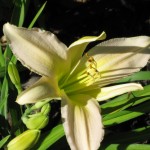Tag: crape myrtles
Daylilies and friends
This past week heralds the arrival of the daylilies. The Dallas Stars are a vigorous bunch of daylilies planted in the front bed that can endure periods of part shade. Our newest arrivals are nearly yellow with a hint of pink. The past few weeks have also seen the crape myrtles blooming full blast. Not to be outdone, our first Desperado Sage is covered in bright lavender pink blooms, that contrast well with the silvery gray foliage.
Texas summer months not for planting
Lessons learned about Texas gardening: don’t plant in June (through September) unless you want your new plants to fry. It’s generally good advice to refrain from summer plantings because the new plants rarely have had enough time to establish root systems to weather the scorching heat. It’s also not a good time to experiment unless one has disposable cash flow for it. So I’m skeptical that the impatiens we put out in the part shade front garden will survive the heat.
It is however a good time to get mulching. Any ground left bare should get a liberal cover of mulch to protect them from losing too much moisture this summer.
Meanwhile, it’s time to think about those fall plants by perusing the catalogs. The honey wants a new crape myrtle, and it appears that Petit Jean Foothills Nursery has a nice visual rundown of the most common cultivars available in the trade. There is of course crapemyrtles.com (supposedly the most popular site for such things) but the poorly-designed site gravitates toward selling dwarfs and provides little info on other cultivars. Another site provides a download of some of the newest cultivars out in the market. Of course, the most comprehensive site would be an agricultural database such as the Texas A&M archives or University of Arkansas Agricultural Division.
A resource for Texas-tested and approved plants is PlantsforTexas.com. Their plant list contains some very hardy plants that can weather the harsh climate. Most of these plants are recognizable and frequently used in Texas landscapes, so it’s a great site for shopping for future specimens.
For seasonal annual color, the A&M list found at this location provides some good recommendations for the Texas garden.

























